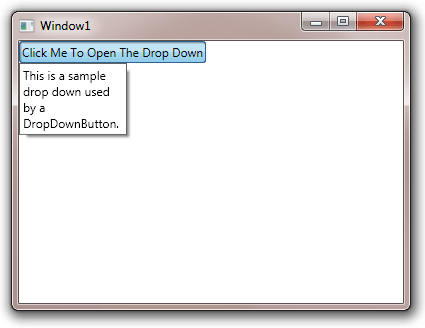Table of Contents
- Getting Started
- EO.Pdf
- EO.Web
- EO.WebBrowser
- EO.Wpf
- Overview
- Installation & Deployement
- Skin & Theme
- Common Taskes and Services
- EO.Wpf Buttons
- EO.Wpf Calendar & DatePicker
- EO.Wpf ComboBox
- EO.Wpf DockView
- EO.Wpf Gauge
- EO.Wpf ListBox
- EO.Wpf Menu
- EO.Wpf MaskedEdit
- EO.Wpf ProgressBar
- EO.Wpf Slider
- EO.Wpf SpinEdit
- EO.Wpf SplitView
- EO.Wpf TabControl
- EO.Wpf TreeView
- EO.Wpf Utility Controls
- EO.Wpf WindowChrome
- Sample Data Objects
- Common Topics
- Reference
| Drop Down Button |
EO.Wpf DropDownButton offers a single control that combines a button and a DropDown control. The following sample demonstrates how to use the DropDownButton control:
XAML
<Window x:Class="Test.Window1" xmlns="http://schemas.microsoft.com/winfx/2006/xaml/presentation" xmlns:x="http://schemas.microsoft.com/winfx/2006/xaml" xmlns:eo="http://schemas.essentialobjects.com/wpf/" Title="Window1" Height="300" Width="400"> <StackPanel> <eo:DropDownButton Width="200" HorizontalAlignment="Left"> <eo:DropDownButton.DropDown> <eo:DropDown> <StackPanel Margin="3" Width="100"> <TextBlock TextWrapping="Wrap"> This is a sample drop down used by a DropDownButton. </TextBlock> </StackPanel> </eo:DropDown> </eo:DropDownButton.DropDown> Click Me To Open The Drop Down </eo:DropDownButton> </StackPanel> </Window>
The above code produces the following result:

You can also use EO.Wpf DropDownService to achieve similar result. There are a few key differences between using DropDownService and DropDownButton:
- DropDownButton automatically render itself as pressed when the drop down is open;
- DropDownButton provides a set of "short cut" properties for the DropDown control that it uses. For example, DropDownButton provides IsDropDownOpen property for you to open or close the drop down;
- DropDownButton allows you to use a child element, instead of the whole control as the triggering element for the drop down. The element that triggers the drop down is marked by name PART_DropDownTarget in the DropDownButton's control template. SplitButton uses this feature to "split" button so that the drop down opens only when user clicks the drop down arrow on the button.

